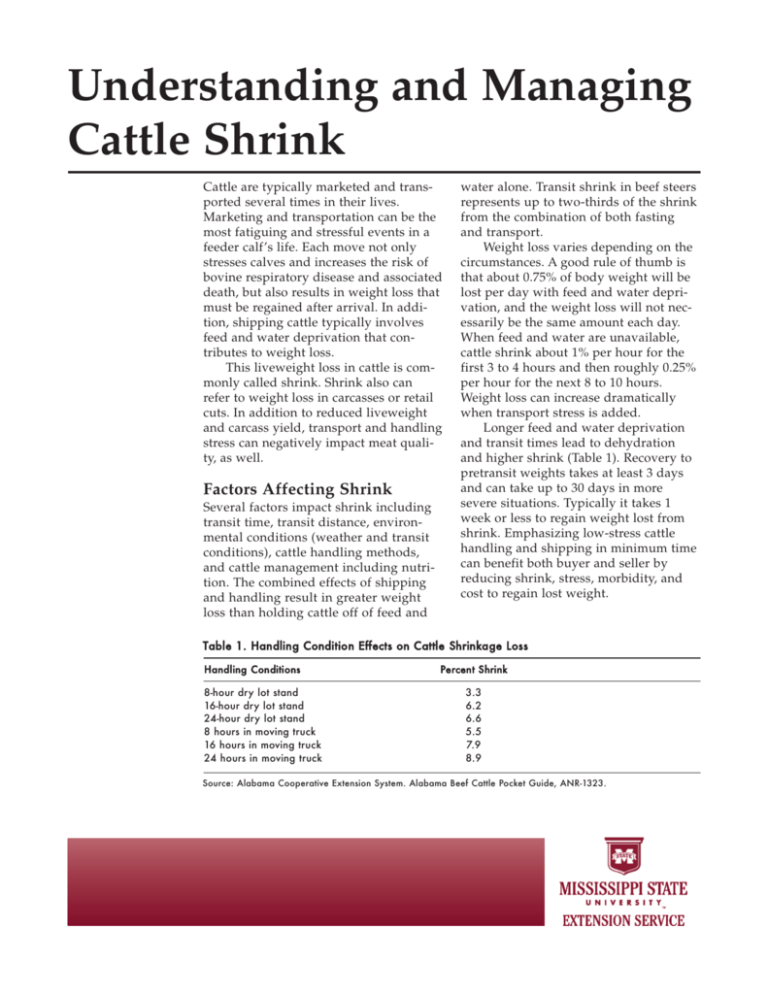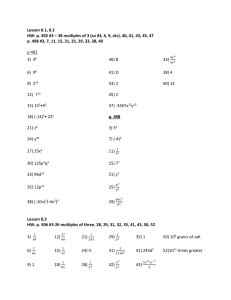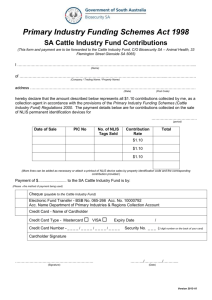
Understanding and Managing
Cattle Shrink
Cattle are typically marketed and transported several times in their lives.
Marketing and transportation can be the
most fatiguing and stressful events in a
feeder calf’s life. Each move not only
stresses calves and increases the risk of
bovine respiratory disease and associated
death, but also results in weight loss that
must be regained after arrival. In addition, shipping cattle typically involves
feed and water deprivation that contributes to weight loss.
This liveweight loss in cattle is commonly called shrink. Shrink also can
refer to weight loss in carcasses or retail
cuts. In addition to reduced liveweight
and carcass yield, transport and handling
stress can negatively impact meat quality, as well.
Factors Affecting Shrink
Several factors impact shrink including
transit time, transit distance, environmental conditions (weather and transit
conditions), cattle handling methods,
and cattle management including nutrition. The combined effects of shipping
and handling result in greater weight
loss than holding cattle off of feed and
water alone. Transit shrink in beef steers
represents up to two-thirds of the shrink
from the combination of both fasting
and transport.
Weight loss varies depending on the
circumstances. A good rule of thumb is
that about 0.75% of body weight will be
lost per day with feed and water deprivation, and the weight loss will not necessarily be the same amount each day.
When feed and water are unavailable,
cattle shrink about 1% per hour for the
first 3 to 4 hours and then roughly 0.25%
per hour for the next 8 to 10 hours.
Weight loss can increase dramatically
when transport stress is added.
Longer feed and water deprivation
and transit times lead to dehydration
and higher shrink (Table 1). Recovery to
pretransit weights takes at least 3 days
and can take up to 30 days in more
severe situations. Typically it takes 1
week or less to regain weight lost from
shrink. Emphasizing low-stress cattle
handling and shipping in minimum time
can benefit both buyer and seller by
reducing shrink, stress, morbidity, and
cost to regain lost weight.
Table 1. Handling Condition Effects on Cattle Shrinkage Loss
Handling Conditions
8-hour dry lot stand
16-hour dry lot stand
24-hour dry lot stand
8 hours in moving truck
16 hours in moving truck
24 hours in moving truck
Percent Shrink
3.3
6.2
6.6
5.5
7.9
8.9
Source: Alabama Cooperative Extension System. Alabama Beef Cattle Pocket Guide, ANR-1323.
Weanling calves of similar genetics can vary
greatly in transit shrink percentages. Cattle with
temperament problems may have higher levels of
shrink. Preweaning management also affects pretransit weight. Lighter calves experience less percentage
shrink than larger calves. Similarly, older cattle tend
to lose more weight during transit and feed deprivation than younger cattle but also tend to regain lost
weight faster.
The amount of fill can affect the degree of shrink.
Lush grass, silage, and haylage diets usually produce
more gut fill than hay or high-concentrate diets.
Cattle shipped directly off of milk and grass may
undergo a greater percentage shrink than cattle off of
a preconditioning or hay and grain diet. In addition,
calves shipped directly off of their dams must deal
with weaning stress and possible unfamiliarity with
feed bunks and water troughs.
Many producers attribute shrink to loss of gut
fill alone. Although much of this weight loss is gut
fill, feces, and urine that can easily be replaced, some
is actual loss of fluid from body tissue. Fecal loss
accounts for approximately 65% of the total weight
lost, and urinary excretions account for about 28% of
the weight lost. This leaves 7% weight loss from
another source, likely body tissue fluids (from carcass components). Tissue loss takes longer to regain
than weight loss from urine and feces. Because muscle contains more water than fat, higher levels of
shrink are typically encountered in cattle with higher
lean-to-fat ratios. Therefore, cattle frame size, age,
sex, and body condition can impact degree of shrink.
Managing Shrink
Management strategies to deal with transport stress
and reduce shrink include preconditioning programs, rest periods during and after transit, potassium supplementation, and use of electrolyte solutions. Transported or feed- and water-deprived cattle
are challenged with a mild metabolic acidosis, which
may be the result of body water loss. Electrolyte
solutions or water can help alleviate this dehydration and some stress in transported cattle.
Any added stress such as overloading the truck,
unfamiliarity with confinement, or extreme temperature and moisture conditions can increase shrink.
Early-weaned calves maintained on-site before shipping might be more tolerant of the stressors associated with transportation and feedlot entry. Although
there is no difference in shrink, there is a notable difference in recovery of lost weight. Early-weaned and
preconditioned calves have an advantage over traditionally weaned calves in weight recovery.
Transportation shrink generally varies more
between years than between preweaning management systems. This suggests that climatic conditions
may be a major factor in body weight loss for transported beef calves. Be familiar with weather forecasts, and avoid working or transporting cattle during extreme temperatures. Protect animals from
weather during hauling.
Shrink can be managed by improving cattle handling conditions. Move slowly and quietly when
handling and loading cattle. Avoid rough cattle handling. For cattle working, get help from people
familiar to both the managers and cattle. Sort cattle
at the ranch of origin. Avoid exposing cattle to
strange environments such as new pastures, pens, or
groups of cattle without first preconditioning them.
Select cattle for improved temperament.
Do not overcrowd cattle in trailers. Group them
into compartments to take pressure off end animals
when the truck starts, turns, or stops. Avoid underloading trailers to reduce stress and bruising. Keep
trips as short as possible. Prevent equipment breakdowns by maintaining scales, handling facilities,
trucks, trailers, and other equipment. Allow cattle
to rest during long hauls. Avoid transporting cattle
on rough roads, and always provide them with
good footing.
Provide feed and water to cattle when possible,
and pay attention to their quality during rest stops
and at the destination. Avoid stressful diet changes
just before shipping, and be sure to allow free-choice
access to grass hay. Withhold water 2 to 3 hours
before shipping. Withhold grain and alfalfa or clover
hay at least 12 hours before shipping because these
feedstuffs have a laxative effect on cattle.
Precondition cattle coming off of lush forages or
high-moisture feeds with a dry feed to limit scouring
and excessive urination.
Economic Impacts of Shrink
Weight is an important factor in determining calf
value. In order to determine fair market prices, buyers and sellers must account for shrink appropriately. Cattle buyers need to understand the costs
involved with regaining lost weight. Shrink in feeder calves commonly falls within 2% to 8% of
liveweight but can be higher under extreme conditions. Pen averages for shrink in the Mississippi
Farm to Feedlot Project for cattle shipped from
Mississippi to Kansas with a minimum 14-hour transit ranged from 5.59% to 8.71%. Slaughter steer
shrink is also important. It often ranges from 2% to
6% and influences dressing percentage (the ratio of
hot carcass weight to liveweight).
Uncertainty in cattle weights adds to the challenge of determining a fair market price based on
weight. Cattle are weighed at a single point in time,
but what happens before or after the weights are
recorded can vary. For instance, shrink differences
can be expected if calves are tanked up on water or
feed versus being held off of water and feed. Savvy
buyers recognize “overfilled” cattle and discount
them. Differences in water intake can be expected
with different environmental conditions, as well.
An often-overlooked method for reducing the
impact shrink has on the bottom line is to include it
as a negotiating point when selling farm-fresh
calves. Many board sales and private treaty contracts
are based on a 2% to 4% pencil shrink. Pencil shrink
is an estimated shrink used in many marketing
transactions. It is a deduction from an animal’s
weight to account primarily for fill. It is important to
specify weighing conditions and times in the transaction to ensure fairness of the price. For instance, if
calves will be transported to scales, that initial
shrink will not be considered and could result in a
reduced pay weight for the seller.
An example of factoring shrink into calf price is
as follows:
When buying cattle, calculate a price that compensates
for shrink. Suppose 600-pound calves sold for $1.05 per
pound. The total value would be $630 per head. If the
shrink was 4% (24 pounds in this case), then the delivered weight would be 576 pounds per head. The value
of the weight delivered would be $630 / 576 pounds =
$1.09 per pound.
When selling cattle, calculate a net price after shrink
allowance. If a 4% pencil shrink was imposed on this
transaction, then the total amount received per head
would be 576 pounds (delivered weight after shrink
applied) x $1.05 per pound = $604.80 per head.
Another way to calculate the total amount received per
head is to decrease the price per pound by 4% and use
the initial, preshrink weight: $1.05 per pound x .96 (to
account for 4% shrink) = $1.008 per pound, $1.008 per
pound x 600 pound per head = $604.80 per head.
Shrink is an inevitable yet manageable part of
transporting cattle. Improvements in calf preconditioning programs, pretransit cattle management, cattle handling, shipping conditions, and management
after arrival can help both cattle buyers and sellers.
Understanding the factors affecting shrink can help
producers and their customers make more informed
marketing and purchasing decisions that more accurately and fairly account for shrink. The degree of
actual shrink, how shrink is estimated and accounted for in marketing transactions, and how shrink
impacts subsequent cattle performance and production costs ultimately influences net returns.
For more information on cattle shrink or related
topics, contact an office of the Mississippi State
University Extension Service.
References
Alabama Cooperative Extension System. 2008.
Alabama Beef Cattle Pocket Guide. ANR-1323.
Auburn, AL.
Phillips, W. A., J. W. Holloway, and S. W. Coleman.
1991. Effect of pre- and postweaning management system on the performance on Brahman
crossbred feeder calves. J. Anim. Sci. 69:31023111.
Phillips, W. A., P. E. Juniewicz, and D. L.
VonTungeln. 1991. The effect of fasting, transit
plus fasting, and administration of adrenocorticotropic hormone on the source and amount of
weight lost by feeder steers of different ages. J.
Anim. Sci. 69:2342-2348.
Schaefer, A. L., S. D. Jones and R. W. Stanley. 1997.
The use of electrolyte solutions for reducing
transport stress. J. Anim. Sci. 75:258-265.
Copyright 2009 by Mississippi State University. All rights reserved. This publication may be copied and distributed
without alteration for nonprofit educational purposes provided that credit is given to the Mississippi State University
Extension Service.
By Dr. Jane A. Parish, Associate Extension/Research Professor, Animal and Dairy Sciences, and Dr. Justin
D. Rhinehart, Assistant Extension Professor, Animal and Dairy Sciences
Discrimination based upon race, color, religion, sex, national origin, age, disability, or veteran’s status is a
violation of federal and state law and MSU policy and will not be tolerated. Discrimination based upon
sexual orientation or group affiliation is a violation of MSU policy and will not be tolerated.
Publication 2577
Extension Service of Mississippi State University, cooperating with U.S. Department of Agriculture. Published in
furtherance of Acts of Congress, May 8 and June 30, 1914. MELISSA J. MIXON, Interim Director
(POD-11-09)








